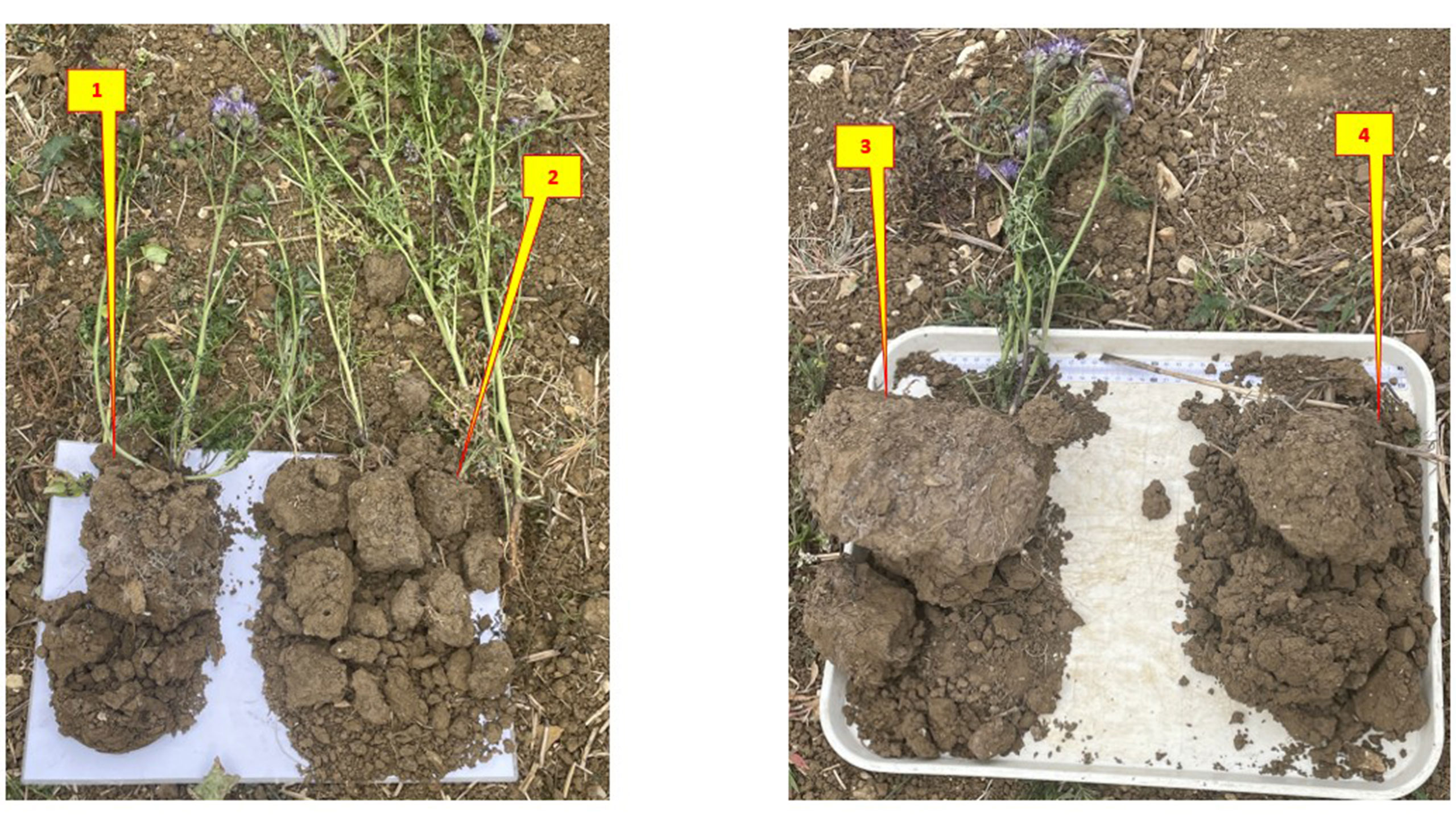How trial is cracking calcite problem in high-calcium soils
A trial is looking at how to break up the hardened calcite layer which is being increasingly seen in some high-calcium soils.
Independent soil consultant David Purdy highlights that the heavy silty clay soils at the Lamport site are very high in calcium relative to magnesium, with a 40:1 ratio compared with an ideal level of 7:1.
See also: Trial reveals cost of unnecessary soil cultivations
Soil samples from the trial

© MAG/Richard Allison
1 Simba X-Press then direct-drilled with Weaving GD “better establishment, but still a tough plate”
2 Meir Soil Conditioner, then X-Press then direct drill drill “best establishment and structure”
3 Direct drill only “slow emergence, tough plate”
4 Bare fallow, not drilled “tough plate, missed opportunity”
Adding amendments such as gypsum is also not suited to these soils as this releases magnesium which then further unbalances the calcium-magnesium ratio.
To illustrate the impact of these high calcium levels, he notes that calcium results in flocculation, thereby pushing apart the clay particles and loosening soil when it is moist.
“But when high calcium soils dry out, the opposite happens, with a hard calcite plate forming in the soil surface to about eight to 12cm depth.”
Calcite layers can create physical barriers to root penetration, air passage, and infiltration, limiting the depth and extent of root growth.
These layers are being seen more in the UK, and the one at Lamport is typical of the more severe cases that independent cultivations expert Philip Wright has experienced.
The high silt content has exacerbated this issue further, as silt particles are ideally sized to block smaller pores in the soil.
The concern is that this layer could be impairing cover crops, which are a key tool for managing blackgrass and improving soil structure in the Lamport system.
David says in countries such as Egypt, farmers use irrigation to remove this layer, but this is not practical in the UK.
Therefore, one of the trials at Lamport is looking at using low disturbance soil surface stretching, in this case prior to establishing a multispecies summer cover crop as a potential way of breaking up the layer.
The untreated plot is bare stubble while the treatments include:
- Shallow plough, level soil and leave fallow
- Shallow plough and drill cover crop with the Weaving GD drill
- Direct-drill the cover crop
- Cultivate shallow with a disc cultivator (Simba X-Press) then drill the cover crop
- Cultivate with low disturbance legs (Meir Soil Conditioner), followed by shallow disc cultivator, then drill the cover crop
- Cultivate with low disturbance legs then drill the cover crop.
The cover crop is a seven-way mix (phacelia, linseed, buckwheat, vetch, clover, oxeye daisy and wild carrot) and was drilled on 7 April.
These plots will then be planted with winter wheat to see the impact on the following crop.
Results so far
Assessments were made on 14 May, and for the direct drilled-only plot, blackgrass emergence has been poor and there is still the compaction plate remaining which is compromising the cover crop.
Philip says the shallow disc cultivations prior to drilling helped the cover crop to establish by producing some tilth, and they saw a better blackgrass flush.
But cover crop rooting remains poor and the cultivations haven’t broken up the plate.
The best cover crop and blackgrass emergence was seen with the low disturbance legs, followed by shallow disc cultivations.
“The plate has been removed, and the soil structure is now in stable columns, which is more accessible to roots.”
To optimise the Meir action at this shallow depth, the legs had their wings modified by reducing the lift height to reduce the intensity.
“The challenge is to have the cultivation matched to the conditions and depth to be worked.”
He recalls using a conventional tine drill set to remove this compaction, but he was not able to control the depth precisely enough – it was too deep on the ridges and not deep enough in the hollows.
In an ideal world, Philip says they need a contouring action, where the depth can be precisely managed, gently stretching the surface to the depth needed in this case.
“All we are trying to achieve is vertical cracks and not over cultivate.
“The establishing crop then can manage the structuring, and blackgrass is stimulated to emerge in the cover crop, not the commercial crop which then follows.
“Unnecessary soil loosening (either deeper than necessary, or where no compaction exists) generally results in too loose a structure, which is vulnerable to re-compaction and slumping.
“In turn this compromises, rather than supports, yield.” he explains.

